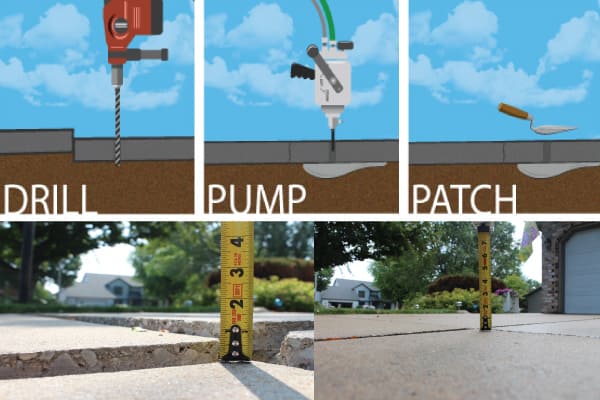Why do you want to do concrete lifting with Polyfoam?
Tired of tripping on your sidewalk, driveway, patio, or pool deck from it being uneven? Driving over what feels like a rocky road in your driveway?
Wondering if I should have the concrete replaced or raised up? Don’t hesitate anymore, you can raise it with polyfoam lifting. This article is going to explain more about raising concrete with foam, including why it’s safe, its benefits, the value it adds to your home, and the reasons behind concrete sinkage.
Why Raising Concrete With Foam is better than mudjacking?
Raising concrete with foam is safer and better than mudjacking. Once the polyurethane foam hardens, it will become inert. Inert means that the foam won’t move. This means that the mixture that created the foam won’t get into your grass or soil. Most companies that claim foam is unsafe are usually mudjacking companies. Mudjacking is an older and outdated method of raising concrete. Mudjacking uses heavier materials and requires more cleanup. There are more holes that are large enough for weeds to grow through them. Water can also get in, leading to shifting slabs and further damage and settling.
What Are The Benefits Of Raising Concrete With Foam?
Raising concrete with Polyfoam comes with five major benefits. It is also perfectly safe for the environment.
1. Polyfoam is faster than other solutions. Polyfoam injections cure in about 15 minutes compared to a full day for mudjacking. It’s less invasive because it requires smaller and fewer drilling holes. It’s stronger, doesn’t retain moisture or pollute the environment, and can reach areas that are inaccessible to mudjacking equipment. If you were to replace your concrete slab, it would take days for the concrete company to come out, tear up your old slab, haul away the debris, pour the new slab, and wait for it all to dry. Also, it would be days before I could walk or drive on.
2. PolyFoam doesn’t require heavy excavation. All that’s needed to pump the foam under your concrete is drilled out dime-sized holes.
3. PolyFoam is lightweight, the foam used only weighs about 2.5 to 4 pounds per cubic foot. That means that the foam won’t add any additional weight on top of the sinking soil. This will prevent further sinkage and create a stronger foundation for your concrete to sit on.
4. PolyFoam is very cost-effective and efficient. If you were to mudjack your concrete, the slurry will wash away during the next heavy rain.
5. PolyFoam is also waterproof. The foam won’t move if it comes in contact with water. It will also still harden if water is present in the soil under your concrete.
What Does Raising Concrete With Foam Do?
If you’re thinking of just leaving your sunken concrete alone, you might want to think again. Here are a few things that raising a concrete slab can do for you.
· Eliminates trip hazards, if your sidewalk is sunken in front of your home, you might want to get that fixed. Save yourself the trouble of tripping and possibly breaking any bones or cracking any teeth.
· Eliminates potential lawsuits. If someone is walking up to your home, such as a mailman or a friend, and they trip over your sidewalk, there’s a chance you might be looking at a lawsuit.
· Adds to your resale value. If you are planning to sell your home, any imperfections will decrease the value of your home during the property appraisal.
· Adds to your home’s appearance. Overall, sunken and cracked concrete slabs look horrible and diminish the appearance of your home.
Why Does Your Concrete Need Raising?
Water washed the soil out from under your slab. Poorly placed gutter downspouts and improper drainage can lead to water flowing toward your concrete and washing the soil out from under your slab.
The soil under your slab wasn’t compacted. Before your concrete is poured, the soil underneath needs to be properly compacted. This will reduce the space between the soil particles and eliminate pockets in the dirt. Without this process, your concrete will sink into the pockets in the soil.
The soil is expansive, sometimes, the soil under your concrete is expansive. This type of soil will swell when it absorbs water and pushes your slab up. Then, when the soil dries, your slab will sink back down. This movement is slow, but over time it can crack your concrete or cause it to sink deeper into the dirt than before.
Tree roots are under your slab. Most experts recommend moving or removing any trees near your concrete slab. Large trees can have invasive tree roots that will swarm under your concrete and lift it up. The tree roots themselves can absorb all the moisture under your slab and cause pockets to form. Lastly, if the tree roots die, they can leave behind more pockets under your slab, which will cause it to sink.
What Companies are Raising Concrete With Foam Near Me?
There are so many waterproofing companies in Des Moines out there, and you might not know who to get in touch with. That’s why you should call BAM Basements and Masons of Des Moines. Since 2012, we’ve been raising all sorts of concrete slabs with foam, including sidewalks, patios, driveways, and more. We also offer foundation repair, basement waterproofing, crawl space repair, and more. Call us today for your free estimate.

